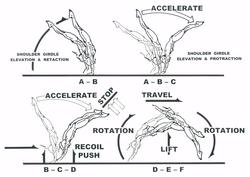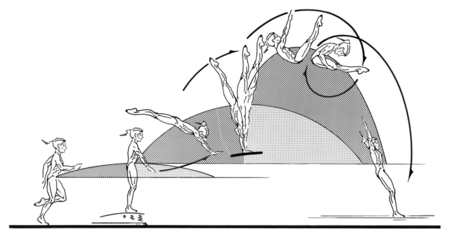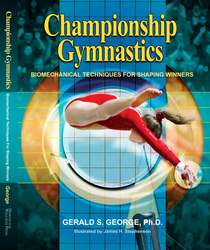|
 | | Figure 6.1 |
Notice these three axial lines are always at right angles to one another and intersect at a conceptual point--the body's center of mass. It is this point (center of mass) about which all rotation of the airborne body occurs. Certain airborne skills are characterized solely by a somersault component, whereas others are characterized solely by a twist component, as shown in Figure 6.2.
 | |
Figure 6.2
|
Because these examples involve rotation about a single axis (uniaxial rotation), they may appear relatively easy to understand and control.
When somersaulting and twisting are combined within the context of a single skill, the situation becomes a bit more complex. Of critical importance in this regard is to realize that a sufficient quantity of somersault rotation must be initiated first prior to any anticipated twist rotation.
Or to put it another way, the wise performer knows she can borrow a portion of the somersault rotation for twisting, but she cannot effectively borrow from the twist rotation for somersaulting. Just as in life:
The bee goes from flower to flower to flower,
But the flower cannot go from bee to bee to bee...
Excerpted from Championship Gymnastics: Biomechanical Techniques for Shaping Winners. For additional information, see Chapter 6, "The Mechanics of Rotation and Twisting," pages 113-138. |
"Championship Gymnastics" -- Featuring 140 Gymnastic Illustrations
Currently Used In 35 Countries Worldwide! |
  140 Illustrations Show You the Exact Positions and Movements for Achieving Success and Shaping Championship Winners. 140 Illustrations Show You the Exact Positions and Movements for Achieving Success and Shaping Championship Winners.
Rather than laboring on complex physics formulas, fundamental principles of biomechanics are clearly explained and presented in layman's terms.
Easy to read and expertly illustrated, readers are guided effortlessly through a "conceptualization process" for developing ideal movement patterns. The book includes 140 technical illustrations by noted artist and gymnastics coach Jim Stephenson.
|
Get the Tools and Learn the Techniques You Need
to Become a Championship Winner!
- Learn Time-Tested Principles for Shaping Winners
- 140 Illustrations Show You the Exact Positions and Movements for Achieving Success and Shaping Championship Winners
- Understand the Biomechanical Principles Underlying All Gymnastics Skills
- Learn the Fundamental Concepts of Proper Training for Power and Flexibility
- Apply an Easy-to-Follow System for the Fundamental Patterns of Gymnastics Movement
- Discover Ten Key Teaching Concepts for Success in Each of the Four Olympic Gymnastics Events for Women
Take this opportunity to be among the first to receive the valuable information contained in this book, and start or continue your journey to achieve success in winning gymnastics championships!
|